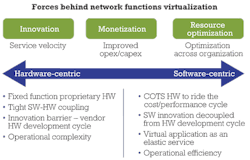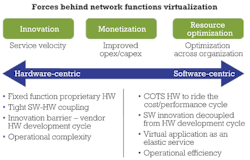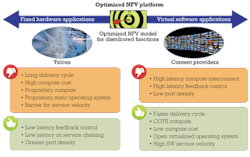By Julius Francis
Carriers and content service providers are experiencing a tsunami in traffic levels fueled by the ever-increasing consumer and business demands driven by over-the-top (OTT) applications and the movement of "all things" into the cloud. To support these levels of traffic -- along with the new and expanded data centers being deployed globally to accommodate them -- network infrastructures have to evolve. That means operators must embrace change -- particularly change that improves network optimization, maximizes agility, and increases monetization.
There are multiple financial, operational, and competitive reasons operators must start alleviating the bottlenecks that exist in network infrastructures today. Operational costs are skyrocketing. Complexity is increasing. Revenues are decreasing. In most cases, this "trifecta of trouble" is unfolding because it takes too long to capitalize on new innovations and incorporate them into services and applications that customers want.
Legacy networks' functions typically are built with fixed, vertically integrated, and propriety operating systems, software, and hardware. These layers are "locked in" together and restrict innovation. Lifecycles for hardware are short, but product development cycles are longer than for the other layers. Software, operating systems, and hardware need to be decoupled to spur innovation and enable new revenue generating services to be tested and launched quickly.
Fortunately, with new open standards for software-defined networking (SDN) and network functions virtualization (NFV), "untethering" software from hardware is for the first time a reality. This decoupling enables more elastic network layers that will be key to deploying new applications and virtualized network functions more flexibly and rapidly.
That said, existing investments in network infrastructure have to be protected. Performance must be maintained. Network operators can't conduct a network overhaul overnight. There must be a transformational approach to existing operational and organizational models. Moreover, there's some risk involved.
But there's clearly much greater risk in doing nothing. Traditional operators are conservative in adopting new technologies, and many wonder what benefits SDN- and NFV-enabled platforms bring. Currently, operating expenses (opex) contribute a major part of an operator's cost of delivering services; as such, optimization is in focus. Many are evaluating SDN and NFV, however, with an eye toward minimizing disruptions to their networks and the customers who depend on them.
Transformation to virtual-network infrastructures
The transformation of network infrastructures has to include network virtualization, centralized policy-centric application integration, and the simplification of underlying networks. It also must be extended beyond the four walls of the data center -- and down the protocol stack to the optical layer. SDN brings virtualization to the networking infrastructure to reduce operational complexity and escalating costs. While initially developed for use cases within the data center, the true value of SDN will be even more fully realized beyond the data center, as it adds automation and programmability to a multivendor network infrastructure layer in an end-to-end manner.
NFV expedites services innovation and velocity and improves economics through open computing, operating systems, and a new network functions environment (see Figure 1). As virtual-network functions (VNFs) are deployed at various distributed and centralized NFV environments, SDN will play a key role in enabling service paths between VNFs to chain them together.
Traditional legacy networks have no idea where or when applications are running because the applications and networks are not integrated. Valuable information necessary to deliver more customized and profitable services simply can't be captured. Especially at the data-center interconnect layer, application-aware intelligent networking enables operators to determine optimal traffic flows, optimize performance, improve network utilization, guarantee service and application assurance, secure transport, and support programmable and automated transport to enhance application experience with superior economics.
Looking at the increasing number of recent infrastructure, control, and orchestration announcements, it's clear that the computing, storage, and networks have to be centered on applications. The underlying infrastructure layer -- which must be built on an intelligent platform as the foundational building block-- is where operators can differentiate. By doing so, they can more meaningfully enhance the experience of the application -- and the subscribers -- through better performance, lower latency, increased security, higher availability, increased utilization, simplified operations, and even improved economics.
NFV offers operators the opportunity to move away from the forced-fit legacy approach to add application awareness. Combined with a move to commercial off-the-shelf (COTS) hardware and open operating systems, the innovation cycle of software also is separated from hardware. That fuels much faster rates of innovation and new services.
NFV promises to enable operators to drive higher margins through better network utilization and innovative service monetization with greater agility. Importantly, this is accomplished while defining and deploying new revenue generating services in "cloud computing" time.
All or nothing?
So, is the next generation network pendulum going to swing all the way from distributed to centralized with all VNFs hosted centrally? Absolutely not. A hybrid network model will prevail -- centralizing what you can and distributing what you must (see Figure 2). There are many VNFs that should move to a cloud model, with others remaining distributed to preserve the application centricity of the underlying network layer without compromising the NFV value propositions.
A balanced hybrid model might have VNFs such as forensic analytics, application optimization, application security, and long-tail functions centralized. These are passive VNFs with slow feedback control. Distributed VNFs would include network analytics probes, network service-level-agreement (SLA) probes, active network security, contextual service assurance, and low latency edge services. Distributed VNFs are characterized by contextual affinity, low latency feedback controls, and consideration of compute versus backhaul costs.
The optimized NFV platform is a key building block in delivering the network transformation (see Figure 3). It needs to have the following dimensions built in:
- Contextual affinity, which is critical in some VNFs that require simplicity, relevance, low latency, and domain control. Examples such as network analytic probes, network SLA probes, application-aware steering, and subscriber/tenant contextual service chaining can be hosted VNFs within intelligent networking platforms.
- A location-agnostic service plane that hosts VNFs should be decoupled from the control and data planes to put the flexibility and mobility of hosting VNFs directly into the hands of the operator. VNF hosting should be application-centric and not be dictated by the tightly coupled legacy approach of fixed networks.
- A distributed service plane with service chaining is possible through the location-agnostic dimension that gives control to the operator to seamlessly transition the VNFs within the distributed platform, local point of presence, or cloud data centers based on changing application-centric demands such as scale, experimentation, and control. The ability to chain these service locations should be built into the service plane. SDN plays a key role in making that possible. The centralized control of the service plane, regardless of where it resides, gives the operator the dynamism and control that applications demand.
- The COTS and open operating-system value must be preserved to ride the cost and innovation curve of COTS compute and open-source community to bring operational simplicity and reduced costs. Bringing the COTS model to server-based hosting is well understood, but preserving the COTS and open operating-system mindset should be architected from the ground up within this new breed of intelligent networking platforms.
When the multilayer SDN control comes together with NFV and application-aware intelligent networking platforms, the true value of application centricity will be integrated with the network layer. This application centricity needs to be extended outside the walls of the data center to deliver an end-to-end application experience.
The pace of transformation
Network operators will introduce changes gradually. The hybrid model, leveraging SDN and NFV, provides a seamless migration path without jeopardizing performance or the integrity of the network. Operators who realize they must respond to the unprecedented levels of traffic traveling across their data centers -- likely to increase with demands fueled by bandwidth-intensive video applications, for example -- will bring new competitive services to market much faster. That, in turn, will allow them to drive additional revenues.
It can no longer take up to a year or more to deliver new services for application-hungry consumers and businesses. Large content providers, such as Facebook and Amazon, are investing heavily to build their own networks for optimal control and keep pace with rapidly changing business demands and requirements. New SDN- and NFV-enabled networking platforms will have the massive density, space, and power savings required for cloud-based services and applications. Importantly, they will also provide network analytics, programmability, and increasingly granular application awareness.
Resistance is futile. Continuing with the status quo of a proprietary, fixed legacy network is akin to the telecom companies that refused to react when Internet-based communications changed the communications field forever. Those companies are no longer a factor in a very vibrant and active marketplace.
Innovation and open environments make the next generation of networks not only feasible but also a reality for operators seeking to more fully capitalize on their networks while optimizing opex with innovative monetization. Vendors can start by building new intelligent networking platforms as building blocks to enable a network fabric that can be monetized.
Network operators can start by enabling "VNF-as-a-service" as the first step toward monetization. If we just focus on driving out the margins of vendors and carriers, we will also drive out innovation and turn cloud networks into a pure utility. Nobody in the communications innovation ecosystem would benefit from that environment.
JULIUS FRANCIS is director of product management at BTI Systems.
Archived Lightwave Issues



